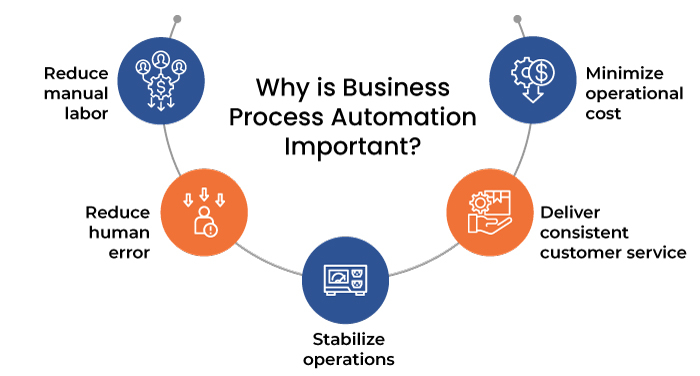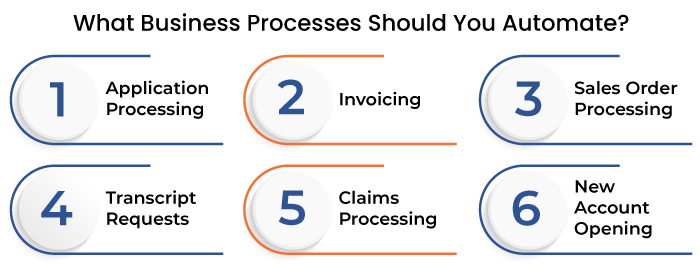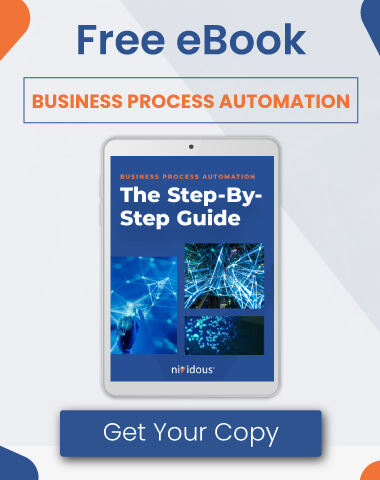Every business has several processes that are necessary for its operation. These processes are often ad hoc and undocumented but have long been transferred from experienced employees to new hires. Businesses can formalize these processes to establish expectations, enhance accountability, and ensure consistent operations. Historically, each step of the process was assigned as part of a job or role and completed manually by each employee on an as-needed basis.
Gradually, technology has replaced manual methods. Automated assembly lines produce hundreds of vehicles daily, while bottling companies employ automation to fill and seal beverage containers. Yet, many businesses still rely on labor-intensive manual processes for their operations.
According to McKinsey, 50% of all business processes can be automated. Allowing technology to handle mundane and repetitive tasks enables employees to dedicate their time to high-value tasks. It’s estimated that just over half of all workers spend at least two hours daily on repetitive manual tasks.
Implementing business process automation can give salespeople an additional day for selling, while programmers would have an extra eight hours for software development. Achieving boosts in productivity without the need to add staff can save companies between 10% and 40% in staffing costs through business process automation (BPA).
What is Business Process Automation (BPA)?
BPA employs software to automate complex, multistep business processes that often interact with multiple systems across an enterprise. It enables organizations to manage and track the operational performance from a holistic standpoint. BPA enables easy data interchange between disparate systems, allowing dashboards and reporting to track key performance indicators.
Business processes consist of a series of actions that can be manual tasks performed by human employees. For instance, a new hire’s onboarding process is repetitive, involving forms to complete and sign, documents to read, and tests to take. Automating this process minimizes the human labor required and ensures a consistent experience for each new hire, allowing them to progress at their own pace.
BPA is also known as Business Process Management (BPM), Digital Business Automation (DBA), or, even more generically, Workflow.
Why is Business Process Automation Important?
Digitization of business processes is a crucial digital transformation initiative. Digital transformation leverages technology to build an infrastructure with the agility and resilience to adapt as markets change. Scaling operations in response to rapid growth can be cumbersome and inefficient without automation.
In addition to contributing to digital transformation, BPA offers several key benefits:
Reduce manual labor. Employees can stop responding to routine emails from company websites and use the time to answer more critical customer requests.
Reduce human error. Even the most accurate data entry staff make mistakes. They may transpose letters or skip a word. Automated processes eliminate human error and improve accuracy.
Stabilize operations. Automated processes standardize operations. They minimize errors and provide a consistent process for employees to follow.
Deliver consistent customer service. BPA follows the same process every time, ensuring a reliable customer experience no matter the time of day.
Minimize operational cost. When redundant or unnecessary steps are eliminated, processes are optimized, and efficiency increases, lowering operational costs.
What Business Processes Should You Automate?
Any time-consuming and repetitive business process is a candidate for automation. The company can benefit significantly from automating any process that inefficiently utilizes an employee’s time. With over 50% of existing processes ready for automation, businesses can select from every department. Here are some examples:
Application Processing
Job applications can take employees hours to review. With BPA, applications can be scanned and analyzed. The software can identify the best-suited applicants. The BPA can also be extended to send a scheduling email to candidates for follow-up interviews.
Invoicing
Automating accounting processes can improve cash flow. Accounts receivable automation can create and deliver invoices. It can send reminders and maintain a digital record of payments. The accounting staff spends hours generating invoices from sales orders. They write letters or emails to include with invoices and must institute a system for checking that payments are received.
Sales Order Processing
Instead of manually entering order details into the system, companies use business process automation technology to scan and extract the necessary information from the purchase order. This technology then automatically generates a sales order with precision. Artificial intelligence checks for any missing components, ensuring accuracy and providing a seamless customer experience.
Transcript Requests
Educational institutions receive transcript requests from graduates. There’s no time limit on how long a transcript is available since graduation, so the number of submissions can be overwhelming. Manual processes often take four to six weeks to respond. Automating the process to allow online requests could have the form digitally processed. The transcripts could be generated and forwarded to an automated device to place the official seal on the document.
Claims Processing
Claims handling is the primary consumer complaint that insurers receive. Many of those complaints focus on delays in handling claims. Automation can expedite claims processing. Filing claims online allows BPA to extract pertinent information and identify missing information. It can notify the claimant and follow up until the information is provided. The process can also keep customers informed on their claim status and process damage assessments.
New Account Opening
As banking has moved online, opening new accounts has become digital. Customers open accounts online and provide the necessary information to comply with country-specific regulations. Customized BPA ensures that documentation is retained to ensure compliance. Data entry errors are reduced, and customer satisfaction increases.
Best Practices for Business Process Automation (BPA)
Organizations with successful BPA implementations follow these best practices:
- Process Discovery – Identify processes that are inefficient, costly, or error-prone.
- Identify Repetitive Tasks – Not every step needs to be automated. Find high-volume tasks that follow defined business rules.
- Prioritize Tasks – The number of possible tasks can be overwhelming, making it difficult to know where to start. An automation strategy allows companies to prioritize tasks to align with their goals.
- Create a Strategy – Start with a clear objective. Knowing the purpose makes it easier to communicate the value of automation to the organization. It will also provide direction. If the goal is to lower costs, the strategy should start with the areas that need to cut expenses. If it’s to manual workloads, look at the areas with the most time-consuming tasks.
- Define Responsibilities – BPA requires a team to define, implement, and maintain the process. An automated process needs input from the primary users and those designing the automation. Each team member needs clearly defined responsibilities. Someone must ensure the BPA is complete and its intersection with other solutions is in place. IT departments are usually responsible for maintaining the software.
Want to find out what the automation process looks like step by step?
Download our Business Process Automation Guide now for a complete overview of automation implementation, including how to measure the success of your efforts.
Why Nividous in 2024
In an uncertain economic landscape, businesses must reduce expenses and increase cash flow. BPA allows organizations to achieve both by lowering labor costs and improving operational efficiencies. Nividous’ automation platform combines advanced technologies, including AI, RPA, and BPA, for comprehensive solutions that can scale with your organization’s growth. To explore how BPA can enhance your operations, take the first step by contacting Nividous.

![Business Process Automation: Your Complete Guide [2023]](https://nividous.com/wp-content/uploads/2023/09/Business-Process-Automation-Your-Complete-Guide-2023-Blog-Feature.webp)





